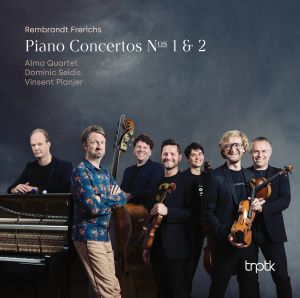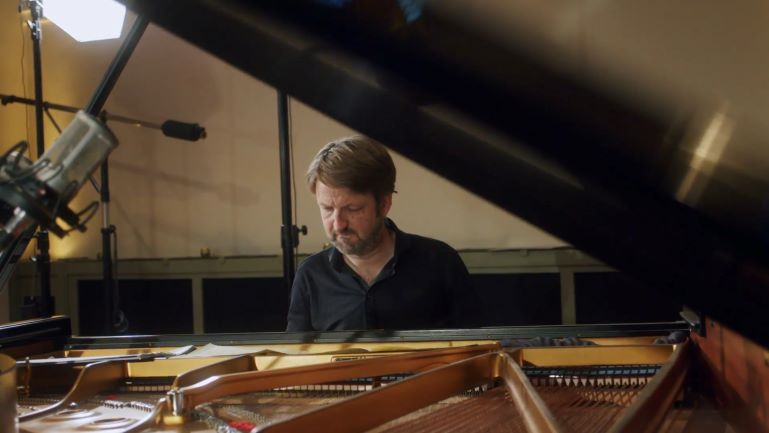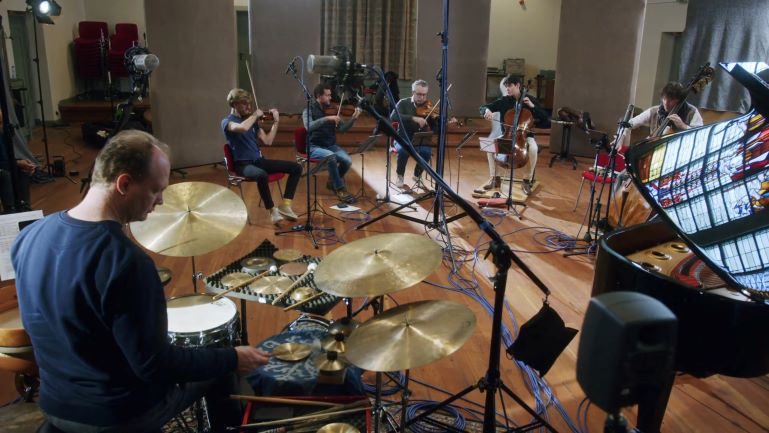Rembrandt Frerichs is a remarkably eclectic and innovative jazz and world musician, synthesizing rhythms and sounds from many cultures. In this thoroughly engaging premier recording of his piano concertos, he collaborates with five string players from the Royal Concertgebouw Orchestra and his long-time partner in The Rembrandt Trio, percussionist Vinsent Planjer. The result is a very special treat.
Rembrandt Frerichs Piano Concertos Nos. 1 & 2, Rembrandt Frerichs, piano, Alma Quartet, Dominic Seldis, bass, and Vinsent Planjer, percussion. TRPTK 2022 (DXD) HERE
Pianist and composer Rembrandt Frerichs (b. 1977) became one of our favorite musicians when we heard his album, Contemporary Fortepiano, released in 2017 HERE. And our respect for him compounded yet again with his recent 2021 release A Wind Invisible Sweeps Us Through the World HERE. In the meantime, we've been pleased to discover his compositions performed by other artists in a variety of recordings, such as the Merel Vercammen's delightful The Zoo, also from TRPTK HERE.
This new album presents yet a further musical adventure for Frerichs—a crossover of the jazz and classical music worlds. Written at the request of musicians of the Royal Concertgebouw Orchestra, his Piano Concertos present a collaborative dialog of classical, jazz and world music elements coupled with the jazz traditions of improvisation while re-invigorating the classical music tradition of extemporization.
Frerichs planned a work in which the string parts would be written out, as normal, but the piano sections would be blank—the music to be determined only at the time of performance. Frerichs: "For a long time it was unclear how the concert would sound in its entirety. The string players didn't have a picture of the embedding of the piano yet. At the rehearsals I would say something like: I'm going to do something here, but what that is I'll figure out during the concert. The penny didn't drop until we played for an audience for the first time at the Oranjewoud Festival and the musicians heard the piece in its entirety. You could truly read on their faces, 'Aaaah so this is what he meant…' That moment can be heard during the second movement of the Piano Concerto No. 2." From the liner notes.
We sometimes forget that this is precisely how Mozart or Beethoven would have played in concert. We are so used to the written score being handed down over the centuries, that we often fail to realize that they would often extemporize their own parts on the piano as the performance proceeded. And, indeed, this is true of many baroque music works in which the composer simply indicates to the soloist "extemporize here."
Frerichs says about his goals, "Whilst starting on this piece, I thought it was very important that I have a totally free role. There are only a couple of places where I am playing on the piano exactly the same, at the same time, with the musicians. I think it is so much nicer for the public when they hear this recording or hear it live that they truly experience me creating comments on what they play, or creating contrasts with what they play, or teaming up, on that very moment."
A particular delight was to find Frerichs revisiting his very lovely song A Wind Invisible Sweeps Us Through the World in the sixth movement of his first piano concerto. The adaptation was pleasure to hear in the overall context of the concerto with the addition of the string players.
As one will expect from Rembrandt Frerichs, if you've listened to any of his music, the concertos are innovative and draw from a wide range of influences. Contrasts are sharp, highly inflected, and brilliantly executed. His own playing is fluid, graceful, and full of the subtle inflections that add depth and complexity. As Alma Quartet's first violist says of the music, "It's a travel between very different styles and cultures and countries. There's a bit of everything. I mean, there's jazz as classical, there's a bit of Balkan, there's Indian … I think what Rembrandt did is really good incorporating these many styles but still making it a cohesive piece." (From promo video with comments from the composer and the musicians, HERE.)
Vinsent Planjer's percussion is, as always, inventive, articulate, and spot on to counterpoint or supplement what else is happening in the music. I truly enjoy/appreciate the sparseness of his additions. He doesn't take over and go on mindless explorations of sound. When he enters the soundstage, he is there with purpose; he adds immeasurably to the musical conversation. My belief, without knowing for certain, is that Planjer has as much an improvisational role in these performances as does Frerichs. They have played so long together, they can perform as one blended mind to accomplish Frerichs' goals.
And Frerichs has not left his string players to simply provide continuo support. No indeed. He challenges them as full partners in these works. Perhaps to their surprise as he leads them into some rhythmically challenging segments that are perhaps not that usual to the classical music performance world. As Dominic Seldis, bass player in the ensemble, comments, "Rembrandt is extremely trusting with his musicians. He will say something which is inspiring rather than an order. That is for a classical musician, who is not used to improvising very much, on the one hand very scary, but on the other very freeing."
There is a constant, exhilarating ritual dance going on between ensemble and piano. These two partners contest with one another, occasionally coalesce with one another. But there is always a strong dynamic tension generating drama and engagement. The ensemble has a score, black dots on paper, to follow. Their path is defined. Frerichs, on the other hand, has a blank page. It is unfair. It is also very engaging for the listener wondering what might come next.
I would love to hear in an alternate performance, on a different day, what Frerichs might choose to do. For today's performance, I simply stand and applaud. Highly recommended.
Recording engineer Brendon Heinst of TRPTK delivers for us another outstanding aural treat. If you delight in excellent sonics that sound like the real thing, as do I, Brendon's recordings are a must listening experience. The performance was recorded in the acoustically quite wonderful Studio 150 inside the Bethlehemkerk, Amsterdam.
Brendon uses a primary microphone array that is the basis for all his recordings. He explains that "The basis for all our recordings is our Optimised Omnidirectional Array (OOA) of microphones, which I developed for my Master's Degree in Audio Engineering in 2013. The aim of OOA is to create a truly accurate image of the soundstage, while retaining uncolored transparency in the tonal characteristics of the recording. This means, in musical terms, that every little detail of the original performance and its acoustic surroundings is accurately recorded, and perfectly reproduced."
While he may additionally use a range of supplemental microphones to fully capture or enhance the sound of different instruments, the use of this primary OOA microphone set consistently delivers an excellent and natural sounding soundstage in each of his recordings. It is this characteristic of his recordings that keeps me eagerly awaiting each new release from TRPTK.
Session photos and video by Michal Grycko. All images courtesy of Brendon Heinst and TRPTK.















































